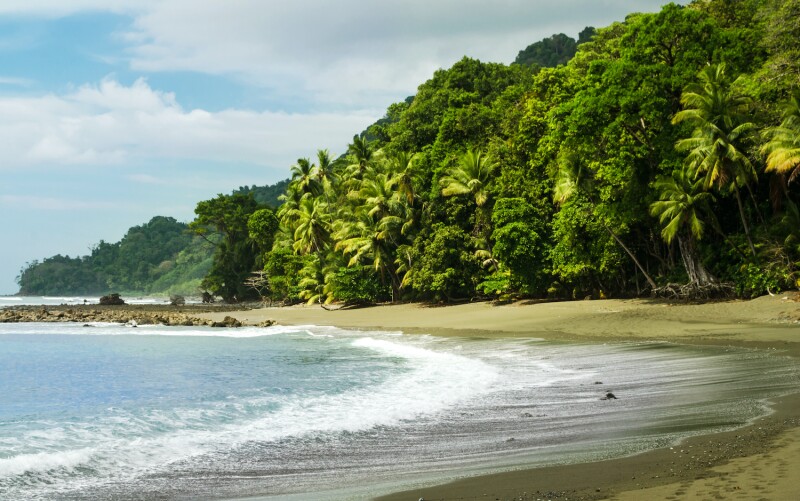Starting on November 1, all U.S. travelers will be allowed to enter Costa Rica without proof of a negative COVID-19 test result, something the destination had been requiring of visitors after transitioning from a mandatory travel quarantine.
After closing its borders to international travelers on March 18 (other than to those who submitted to a 14-day quarantine order) to control the spread of coronavirus, the Central American country began welcoming some international travelers back on August 1.
Since August 19, citizens and residents from these regions and countries have been able to enter Costa Rica: the European Union, the Schengen Zone, the United Kingdom, Canada, Uruguay, Japan, South Korea, Thailand, Singapore, China, and New Zealand.
Starting in September, residents from select U.S. states were welcomed back to Costa Rica—they were required to provide a driver’s license or a state I.D. as proof that they live in one of the authorized states. But beginning November 1, proof of residency will no longer be required as Costa Rica opens to travelers from all U.S. states. And neither will a COVID-19 test.
Travelers to Costa Rica will only need to fill out a health form and provide proof of health insurance

You can head to the Costa Rican shore with a flight, a form, and health insurance.
Photo by Shutterstock
Before flying to Costa Rica, visitors will need to fill out an epidemiological health form online. Evidence of a negative polymerase chain reaction (PCR) COVID-19 test result prior to arrival in Costa Rica is no longer required as of October 26.
In light of the fact that Costa Rica is no longer requiring either a negative test result or a quarantine, Costa Rica’s tourism minister Gustavo Segura urged travel companies on the ground in Costa Rica as well as travelers to remain vigilant and follow health and safety protocols in order to ensure that coronavirus transmission remains under control as the country works to reignite its tourism economy.
Segura asked tourists “to practice tourism responsibly, following all the precautionary measures that have been recommended to avoid contagion.”
International arrivals will still need to show proof of international health insurance coverage, either from their own provider or that they purchased in Costa Rica (local insurance policies authorized for travelers are available through the National Insurance Institute and through insurance company Sagicor). For international insurance policies, tourists must provide verification that their insurance company will cover them in Costa Rica; will cover at least $50,000 in medical expenses in the event they contract COVID-19 while in Costa Rica; and will cover a minimum of $2,000 in lodging expenses for any issues related to the pandemic (such as the need to quarantine).
Upon arrival, travelers could also be subject to temperature checks.
Commercial flights are operating into and out of Costa Rica’s three international airports: Juan Santamaría International Airport outside of the capital San José, Daniel Oduber Quirós Airport in Liberia, and Tobías Bolaños Airport in San José. Starting on September 13, United Airlines added daily flights from Houston, Texas, to Juan Santamaría International Airport, and three flights a week from Houston to Daniel Oduber Quirós Airport. United plans to add flights from Newark International Airport to Juan Santamaría International Airport and to Daniel Oduber Quirós Airport in October as well as flights from Colorado. American Airlines is adding flights to Daniel Oduber Quirós Airport from Miami and from Dallas. Delta plans to fly to Costa Rica from Atlanta as well.
In Costa Rica, travelers must wear masks at the airport and comply with local health regulations, including practicing physical distancing. As of August 31, hotels in Costa Rica are allowed to operate at 100 percent capacity, with the exception of public areas, which will be required to limit capacity to 50 percent. For up-to-date information and guidelines regarding COVID-19, travelers can visit the Ministry of Health’s website.
During the pause in tourism arrivals, Costa Rica tourism officials focused on training the workforce on new coronavirus-friendly health and sanitation guidelines and protocols. Costa Rica was recently recognized by the World Travel & Tourism Council (WTTC) through its “Safe Travels” stamp for its commitment to updated health and safety measures.
As of October 26, there have been more than 104,000 coronavirus cases and 1,300 COVID-19 deaths reported in Costa Rica, according to Johns Hopkins University. The U.S. State Department has assigned Costa Rica with a Level 3 travel advisory, recommending U.S. citizens to reconsider travel there due to COVID-19.
This story originally appeared on August 21, 2020, and has been updated on October 26, 2020, to reflect current information.








